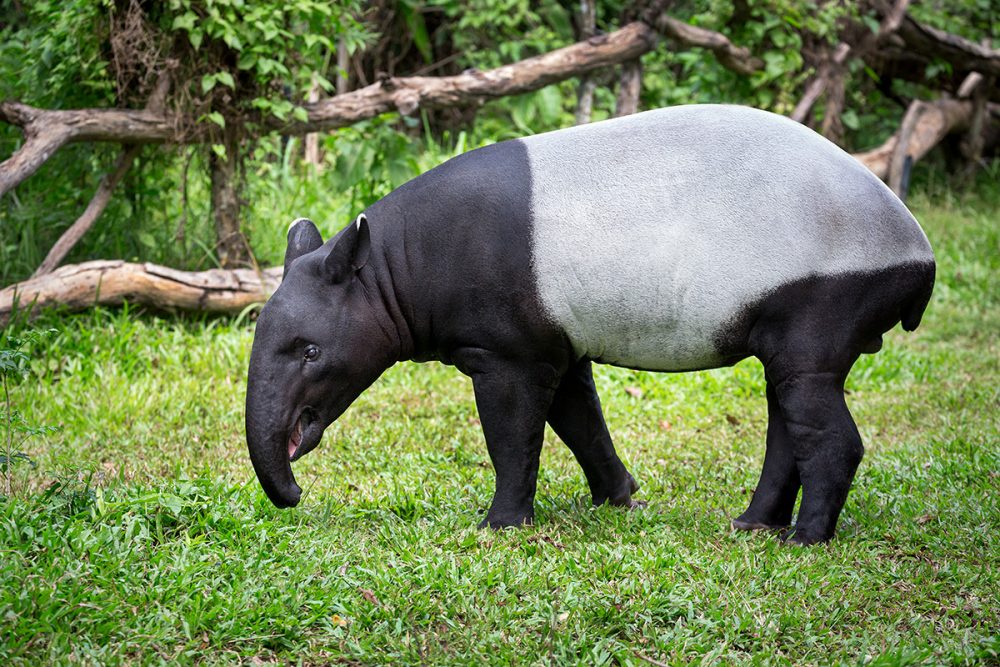I wish I knew what it meant!……..
noun
- the nose of a mammal, especially when it is long and mobile such as the trunk of an elephant or the snout of a tapir

The Poor Tapir
The poor tapir felt awfully bad
Because of the snout he unfortunately had.
It was big and long and moved about
This proboscis of his must move its way out.
The problem with that as you can probably guess
Is the nose was attached to his face.
He wanted to cry and never felt blessed
And kept to his own little space.
©2020 CBialczak Poetry
Written for: https://wordofthedaychallenge.wordpress.com/2020/08/18/proboscis/
The Asian, or Malayan tapir is the largest of the five living species of tapir.
It is also the only surviving old world species. It is characterised by its long, fleshy, prehensile nose and distinctive black and white colouration which apparently breaks up the outline of the body in the gloom of the forests in which it lives. Tapirs are perissodactyls (odd-toed ungulates), a group of herbivores that also includes rhinos and horses – it was a previously a very diverse and numerous group. The origins of Tapiridae can be traced back at least fifty million years, and they have changed little in body plan for 35 million years. Formerly ranging across Southeast Asia, the tapir today exists as a series of isolated populations, the largest of which are in Malaysia. Habitat destruction, especially through deforestation for agricultural purposes, or flooding caused by the damming of rivers for hydroelectric purposes, is largely responsible for historical decline of this species and continues to be the main threat today. Hunting, a relatively minor threat in the past, is also becoming more of a concern; as other preferred prey species are becoming more depleted, hunters are increasingly looking towards tapirs as a food source.
- Order: Perissodactyla
- Family: Tapiridae
- Population: 1,300-1,700
- Trend: decreasing
- Size: 1.80-2.5 m
- Weight: 100-500kg
EDGE SCORE
EDGE Score: 5.73 (?)ED Score: 37.63 (?)GE / IUCN Red List(?)NENot Evaluated DDData Deficient LCLeast Concern NTNear Threatened VUVulnerable ENEndangered CRCritically Endangered EWExtinct in the Wild EXExtinct
DISTRIBUTION
Fragmented populations occur throughout the historical range in Southeast Asia, from southern and central parts of Sumatra (Indonesia) to Peninsula Malaysia, southwest Thailand, and southern Myanmar.
HABITAT AND ECOLOGY
They inhabit tropical moist forests through all ranges, through all a range of altitudes, from the highest peaks in Thailand to the lowlands and lower montane zone in parts of its range. They feed on the twigs and growing tips of a wide range of understory vegetation, and also a variety of fruits and leaves on the forest floor.


Well that’s something I didn’t nose…..
LikeLiked by 1 person
A fun little poem! I will never forget the tapirs at the National Zoo in DC. We took the boys and it was breeding season for the tapirs. They are not quiet breeders! We had to do a lot of explaining!!
LikeLiked by 1 person
Hahaha, that is like when I had to explain chicken sex to my niece!
LikeLike
What a great word, choice of animal, and poem! We’ve seen Tapirs at the San Diego Zoo. They’re cute and odd looking.
LikeLiked by 1 person
Well, I would have never known this word but after learning it and seeing this little odd animal, I am quite happy I learned something new today.
LikeLike
Love learning new things too! Because of your post, I actually went back to the zoo’s website to better remember what we saw at the zoo last year. Hope you keep learning new fun things!!
LikeLiked by 1 person
I love learning stuff…I definitely learn a lot by many of these challenges.
LikeLike
Same here!
LikeLike
I bet other tapirs found him/her cute.
LikeLiked by 1 person
I would like to think so.
LikeLike
Wow, how interesting! I’ve never seen one of those before 💫✨
LikeLiked by 1 person
Neither have I! They are quite odd looking
LikeLiked by 1 person
They are indeed 😊😂
LikeLiked by 1 person
Cute poem.
LikeLiked by 1 person
Thank you
LikeLiked by 1 person
You’re welcome. Glad you had the definition, I didn’t know either. 🙂
LikeLiked by 1 person